The Tienditas Bridge “blockade”
Or how to turn an unopened bridge into an international news story to build support for your coup
Edit: Someone has translated the article into Spanish: Traducción Española
Over the last couple of days, you may have seen an image like this in the news:
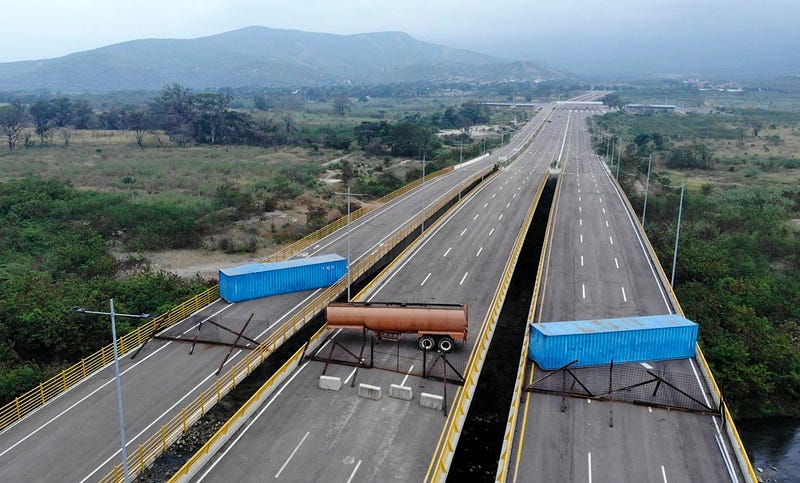
This
is Tienditas International Bridge (Spanish: Puente Binacional
Tienditas) on the border between Colombia and Venezuela. I have a
feeling that we will be seeing much more of this bridge in the news over
the coming days.
Venezuela is a country in crisis. More specifically, a presidential crisis. The president since 2013, Nicolás Maduro, was re-elected in 2018, but the election is disputed by the opposition. An opposition politician, Juan Guaidó, declared himself as interim president on January 23rd 2019 (despite not having stood in the 2018 election). The US and allies (including my country, the UK) have recognised Guaidó as president. Other countries continue to recognise Maduro as president. It appears that Maduro holds more power within the country, particularly as the military still support him.
The presidential crisis is a symptom of ongoing economic and political difficulties within Venezuela. I won’t comment on which side is right or who is to blame for the situation, but I do understand that a lot of people are struggling and suffering.
What I want to cover here is not the situation in Venezuela itself, but the state of media reporting on the situation, and the lack of any scrutiny of US propaganda regarding Venezuela. Let’s return to Tienditas Bridge.
On Wednesday, US Secretary of State Mike Pompeo posted on Twitter:
The Venezuelan people desperately need humanitarian aid. The U.S. & other countries are trying to help, but #Venezuela’s military under Maduro’s orders is blocking aid with trucks and shipping tankers. The Maduro regime must LET THE AID REACH THE STARVING PEOPLE.
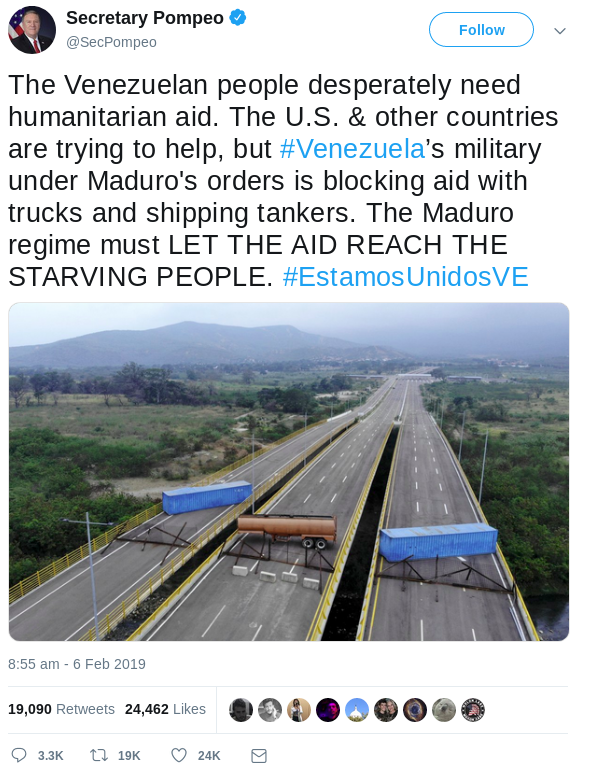
The
photo depicts Tienditas International Bridge, blocked by a fence, a few
concrete blocks, two containers and an oil tanker. This photo along
with Pompeo’s words paint an image of Maduro as a mad dictator who does
not care about the people of his country, and is willing to shut down
and blockade a huge six-lane highway in order to stop them eating.
In the day or so following Pompeo’s tweet, every mainstream news outlet reported on this story, but it appears none of the writers bothered to question the narrative put out by Mike Pompeo. Most of the stories were incorrect and omitted key facts, as I will show.
Here are a selection of the reports. I’ve highlighted the inaccuracies.
BBC News reported:
US Secretary of State Mike Pompeo has demanded Venezuela reopen a bridge on the Colombian border for an aid shipment organised by the opposition.
The Independent reported:
Nicolas Maduro‘s regime blocked the Tienditas International Bridge with a giant orange tanker, two large blue containers and makeshift fencing.
CNN reported:
The Venezuelan government, led by embattled President Nicolas Maduro, has blocked a bridge connecting Venezuela to Colombia, according to Colombian officials and a CNN photojournalist at the scene.
What is wrong with these reports? What have they left out?
Let’s look again at that image again with a little scepticism…
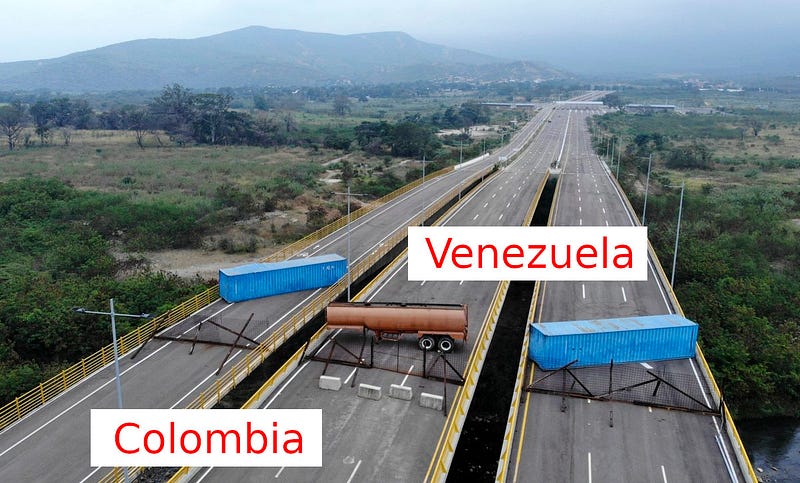
Let’s
assume that Venezuela did indeed place the containers where they are.
The photo was taken from Colombia, looking into Venezuela.
There’s something that doesn’t add up. It looks like the fence, in front of the containers, was erected by Colombia. The fence supports are on the Colombian side, and four concrete blocks also sit on the Colombian side of the fence. So was the bridge really blocked by Venezuela, or was it actually blocked by Colombia?
Luckily, we can view Tienditas bridge on Google Maps:
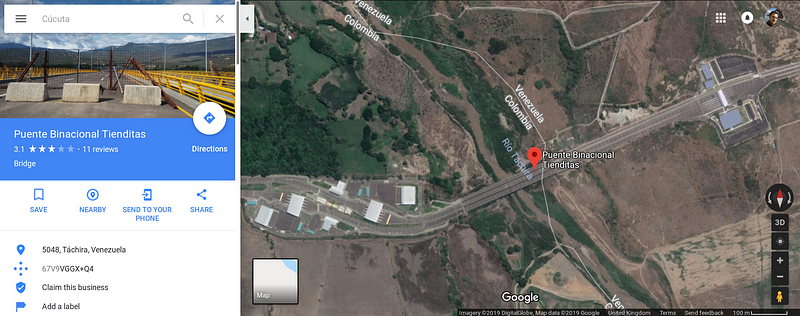
Does the photo look familiar? A fence with concrete blocks, blocking the bridge.
Let’s take a closer look at the photo:
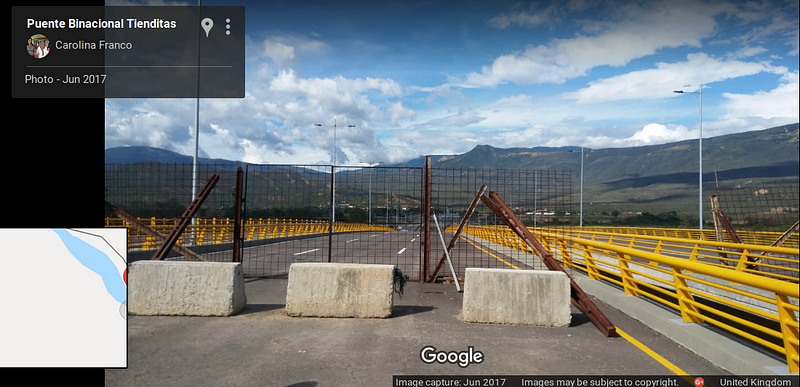
The photo was uploaded in June 2017. Tienditas
Bridge, reported throughout the media as blocked by Venezuela this
week, has in fact been blocked for at least 18 months!
There is also a Wikipedia article on Tienditas Bridge (in Spanish). It says of the bridge (translated to English with Google Translate):
It was concluded in early 2016, but due to the crisis between Venezuela and Colombia in 2015 and the border closure of Venezuela the bridge has not been officially opened.
This is backed up by a reference to an article from La Opinion, a local news site of Cúcuta in Colombia (also in Spanish), which states:
Sheltered by an old rusty gate and a guard, this binational work is still useless because of the border situation, despite the fact that the Invias has already completed 100 percent of the route.
The Google translation may not be perfect, but it seems that Tienditas Bridge has never opened
even though it was finished three years ago, due to a dispute between
Colombia and Venezuela. And the now familiar “rusty gate” has been there
all this time. It’s a complete falsehood to say that Maduro “blocked”
the bridge this week, that it must “reopen”, or that Venezuela erected
“makeshift fencing” this week.
So is the media lying to us? Is there not one mainstream journalist who bothers to do research any more? I suspect a combination of the two:
- Every news organisation takes a journalistic position which is in some way biased, but mostly aligned with the propaganda the US government is putting out.
- The 24-hour news cycle leaves little time for the journalists to put in the necessary research to verify the facts they are publishing.
It’s
a sad state of affairs. I feel I can no longer trust anything I read in
the media, and have to verify everything myself. In this case, there
was enough information available online to do that and find the errors
and omissions, but that usually isn’t feasible. It’s certainly not how I
want to spend my time. I’m not a journalist.
An alternative narrative
I
would like to suggest a different narrative to that provided by Mike
Pompeo and repeated by the media, a narrative which more closely
corresponds to the facts.
The US has stated that it will be sending humanitarian aid to Venezuela, at the request of Juan Guaidó whom they recognise as president.
The Venezuelan government led by the elected president, Nicolás Maduro, is concerned that this will be a cover for shipping weapons into the country which may be used to start a civil war. This is not an unreasonable concern given the US’s history of interventionism, and the Venezuelan authorities claim to discovered an illegal shipment of rifles and ammunition from Miami just this week. Faced with such a threat, it seems quite rational to secure the points of entry through which arms could enter the country.
Since Tienditas Bridge is not in use and has never been, it makes sense to reinforce the existing barrier on the bridge (which may have been erected by Colombia).
How can we improve coverage in the media?
The
quality of output in the media feels lower than I remember it ever
being. I felt despair today as I realised how deceptive this coverage of
Tienditas Bridge has been. I don’t know whether the authors intend to
deceive or are unaware of the role they play as puppets of the US
government’s propaganda.
I will be making a complaint to the BBC, and perhaps other organisations as time allows. I hope others will do the same.
No comments:
Post a Comment